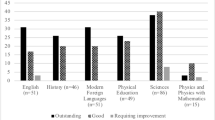Abstract
In this study, we report on our learning as we engaged in a four-month experience of coteaching a water unit in a Grade 7 classroom. Working at each other's elbows, in praxis, provided many opportunities to learn together: teaching and about teaching. We use two examples, learning to ask productive questions and struggling to enact an orderly curriculum to show how coteaching affords colearning, and how the lack of coteaching leads to struggling. Our work also suggests that coteaching allows for a mode of learning that is not captured by Schön's notions of reflection-in-practice and reflection-on-practice. We conclude that coteaching, as colearning, is praxis.
Similar content being viewed by others
References
Bourdieu, P. (1992). The practice of reflexive sociology (The Paris workshop). In P. Bourdieu, & L. J. D. Wacquant (Eds.),An invitation to reflexive sociology. Chicago, IL: University of Chicago Press.
Bourdieu, P. (1997).Méditations pascaliennes [Pascalian meditations]. Paris: Seuil.
Churchland, P. M. (1995).The engine of reasoning, the seat of the soul: A philosophical journey into the brain. Cambridge, Mass: MIT.
Guba, E., & Lincoln, Y. (1989).Fourth generation evaluation. Beverly Hills, CA: Sage.
Harlen, W. (1985).Primary science: Taking the plunge. London: Heineman.
Heidegger, M. (1977).Sein und zeit [Being and time]. Tübingen, Germany: Max Niemeyer.
Joyce, B. R., & Clift, R. T. (1984). Teacher education and the social context of the workplace.Childhood Education, 61, 115–119, 122–128.
Jordan, B. (1987).Modes of teaching and learning: Questions raised by the training of traditional birth attendants. (IRL Report No. IRL87-0004). Palo Alto, CA.
Jordan, B. (1989). Cosmopolitical obstetrics: Some insights from the training of traditional midwives.Social Science in Medicine, 28, 925–944.
Jordan, K., & Lynch, M. (1993). The mainstreaming of a molecular biological tool A case study of a new technique. In G. Button (Ed.),Technology in working order: Studies of work, interaction, and technology (pp. 162–178). London and New York: Routledge.
Lave, J. (1988).Cognition in practice: Mind, mathematics and culture in everyday life. Cambridge: Cambridge University Press.
Lave, J. (1996). Teaching, as learning, in practice.Mind, Culture, and Activity, 3, 149–164.
Ricœur, P. (1990).Soi-même comme un autre [Onself as another]. Paris: Seuil. (English translation published in 1992 by University of Chicago Press)
Ricœur, P. (1991).From text to action: Essays in hermeneutics, II. Evanston, IL: Northwestern University Press.
Roth, W.-M. (1994). Student views of collaborative concept mapping: An emancipatory research project.Science Education, 78, 1–34.
Roth, W.-M. (1998a).Designing communities. Dordrecht, Netherlands: Kluwer Academic Publishing.
Roth, W.-M. (1998b). Science teaching as knowledgeability: A case study of knowing and learning during coteaching.Science Education, 82, 357–377.
Roth, W.-M. (1998c). Teaching and learning as everyday activity. In B. Fraser, & K. Tobin (Eds.),International handbook of science education (pp. 169–181). Dordrecht, Netherlands: Kluwer Academic Publishing.
Roth, W.-M., Bowen, G. M., Boyd, N., & Boutonné, S. (in press).Coparticipation as mode for learning to teach science. In W. Liedke (Ed.),Connections '98. Victoria, BC: University of Victoria.
Roth, W.-M., Masciotra, D., & Bowen, G. M. (1998, October).From thing to sign and “natural object”: Toward a genetic phenomenology of graph interpretation. Paper presented at the annual meeting of the Society for Social Studies of Science, Halifax, NS.
Roth, W.-M., Masciotra, D., & Boyd, N. (in press). Becoming-in-the-classroom: A case study of teacher development through coteaching.Teaching and Teacher Education.
Roth, W.-M., McGinn, M. K., Woszczyna, C., & Boutonné, S. (in press). Differential participation during science converstations: The interaction of display artifacts, social configuration, and physical arrangements.The Journal of the Learning Sciences.
Schön, D. A. (1987).Educating the reflective practitioner. San Francisco: Jossey-Bass.
Shulman, L. S. (1987). Knowledge and teaching: Foundations of the new reform.Harvard Educational Review, 57, 1–22.
van Manen, M. (1994). Pedagogy, virtue and narrative identity in teaching.Curriculum Inquiry, 24, 135–170.
van Manen, M. (1995). On the epistemology of reflective practice.Teachers and Teaching: Theory and Practice, 1, 33–50.
Author information
Authors and Affiliations
Corresponding author
Rights and permissions
About this article
Cite this article
Roth, WM., Boyd, N. Coteaching, as colearning, is praxis. Research in Science Education 29, 51–67 (1999). https://doi.org/10.1007/BF02461180
Issue Date:
DOI: https://doi.org/10.1007/BF02461180




